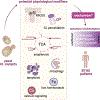Cardiolipin function in the yeast S. cerevisiae and the lessons learned for Barth syndrome
- PMID: 34626131
- PMCID: PMC8755574
- DOI: 10.1002/jimd.12447
Cardiolipin function in the yeast S. cerevisiae and the lessons learned for Barth syndrome
Abstract
Cardiolipin (CL) is the signature phospholipid (PL) of mitochondria and plays a pivotal role in mitochondrial and cellular function. Disruption of the CL remodeling gene tafazzin (TAZ) causes the severe genetic disorder Barth syndrome (BTHS). Our current understanding of the function of CL and the mechanism underlying the disease has greatly benefited from studies utilizing the powerful yeast model Saccharomyces cerevisiae. In this review, we discuss important findings on the function of CL and its remodeling from yeast studies and the implications of these findings for BTHS, highlighting the potential physiological modifiers that may contribute to the disparities in clinical presentation among BTHS patients.
Keywords: Barth syndrome; cardiolipin; mitochondrial disease; tafazzin; yeast.
© 2021 SSIEM.
Conflict of interest statement
Conflict of interest
The authors declare no conflicts of interest.
Figures


Similar articles
-
Cardiolipin remodeling: a regulatory hub for modulating cardiolipin metabolism and function.J Bioenerg Biomembr. 2016 Apr;48(2):113-23. doi: 10.1007/s10863-014-9591-7. Epub 2014 Nov 29. J Bioenerg Biomembr. 2016. PMID: 25432572 Free PMC article. Review.
-
Overexpression of branched-chain amino acid aminotransferases rescues the growth defects of cells lacking the Barth syndrome-related gene TAZ1.J Mol Med (Berl). 2019 Feb;97(2):269-279. doi: 10.1007/s00109-018-1728-4. Epub 2019 Jan 3. J Mol Med (Berl). 2019. PMID: 30604168
-
Cardiolipin deficiency leads to the destabilization of mitochondrial magnesium channel MRS2 in Barth syndrome.Hum Mol Genet. 2023 Dec 1;32(24):3353-3360. doi: 10.1093/hmg/ddad153. Hum Mol Genet. 2023. PMID: 37721533
-
Cardiolipin-deficient cells have decreased levels of the iron-sulfur biogenesis protein frataxin.J Biol Chem. 2020 Aug 14;295(33):11928-11937. doi: 10.1074/jbc.RA120.013960. Epub 2020 Jul 6. J Biol Chem. 2020. PMID: 32636300 Free PMC article.
-
Experimental models of Barth syndrome.J Inherit Metab Dis. 2022 Jan;45(1):72-81. doi: 10.1002/jimd.12423. Epub 2021 Aug 15. J Inherit Metab Dis. 2022. PMID: 34370877 Free PMC article. Review.
Cited by
-
Barth Syndrome: TAFAZZIN Gene, Cardiologic Aspects, and Mitochondrial Studies-A Comprehensive Narrative Review.Genes (Basel). 2025 Apr 18;16(4):465. doi: 10.3390/genes16040465. Genes (Basel). 2025. PMID: 40282425 Free PMC article. Review.
-
Cardiolipin remodeling maintains the inner mitochondrial membrane in cells with saturated lipidomes.J Lipid Res. 2024 Aug;65(8):100601. doi: 10.1016/j.jlr.2024.100601. Epub 2024 Jul 20. J Lipid Res. 2024. PMID: 39038656 Free PMC article.
-
ABHD18 degrades cardiolipin by stepwise hydrolysis of fatty acids.J Biol Chem. 2025 Jun;301(6):110237. doi: 10.1016/j.jbc.2025.110237. Epub 2025 May 14. J Biol Chem. 2025. PMID: 40378955 Free PMC article.
-
Insights into complex I assembly: Function of NDUFAF1 and a link with cardiolipin remodeling.Sci Adv. 2022 Nov 18;8(46):eadd3855. doi: 10.1126/sciadv.add3855. Epub 2022 Nov 16. Sci Adv. 2022. PMID: 36383672 Free PMC article.
-
Mitochondrial phospholipid metabolism in health and disease.J Cell Sci. 2023 Sep 1;136(17):jcs260857. doi: 10.1242/jcs.260857. Epub 2023 Sep 1. J Cell Sci. 2023. PMID: 37655851 Free PMC article.
References
-
- Barth PG, Scholte HR, Berden JA, Van der Klei-Van Moorsel JM, Luyt-Houwen IE, Van ‘t Veer-Korthof ET, Van der Harten JJ, and Sobotka-Plojhar MA (1983) An X-linked mitochondrial disease affecting cardiac muscle, skeletal muscle and neutrophil leucocytes. J Neurol Sci 62, 327–355 - PubMed
-
- Bione S, D’Adamo P, Maestrini E, Gedeon AK, Bolhuis PA, and Toniolo D. (1996) A novel X-linked gene, G4.5. is responsible for Barth syndrome. Nat Genet 12, 385–389 - PubMed
-
- Neuwald AF (1997) Barth syndrome may be due to an acyltransferase deficiency. Curr Biol 7, R465–466 - PubMed
-
- Vreken P, Valianpour F, Nijtmans LG, Grivell LA, Plecko B, Wanders RJ, and Barth PG (2000) Defective remodeling of cardiolipin and phosphatidylglycerol in Barth syndrome. Biochem Biophys Res Commun 279, 378–382 - PubMed
Publication types
MeSH terms
Substances
Grants and funding
LinkOut - more resources
Full Text Sources
Molecular Biology Databases

